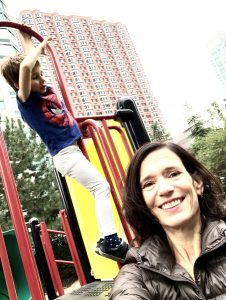
I live in State College, Pennsylvania, though my spiritual home is New York City. After taking my job at Penn State, I held on to a rent stabilized apartment in the East Village for many years, giving it up in 2016. I still spend as much time in the city as possible.
I came from a family where you had to always be reading, and it didn’t matter what, so I pretty much went straight from the Baum Oz books to Mad Magazine. I did have the great good luck to grow up in New York City in the 1980s, which meant discovering as a teenager Art Spiegelman’s Raw magazine and the immersion journalism then prevalent in the Village Voice. In high school, I read a story in the Voice by Carol Mithers called “My Life as a Man,” in which the author went undercover as a man, and I felt a white light burning in a halo around my whole body.
In college, I wrote and studied “literary journalism,” which for me meant imitating the style in what I was reading by Joan Didion—everything from Slouching Towards Bethlehem to what later became the collection After Henry. I was also enamored of an anthology called Raising Hell: How the Center for Investigative Reporting Gets the Story. This included one essay that made a lasting impression on me, by Suzanne Gordon about the self-improvement cult est. The writer described a scene interviewing the movement’s megalomaniacal leader, Werner Erhard, in which he sat in a rolling chair with a high seat and asked the reporter to sit in a stationary chair with a low seat. Her interpretation and description of the ensuing power dynamic was, I thought, brilliant and hilarious.
I suppose you could call this genre immersive, participatory, risk-taking personal writing. Much of the writing was by writers who chose to undergo unusual experiences and then present the experiences in a reflective, diary-like style. Two of my first published pieces were about going undercover as a woman seeking breast implants at fancy plastic surgery practices on Park Avenue in New York, and as a woman donating her ova for another woman to get pregnant (I never planned to go through with either medical procedure).
Later, I realized that Simone de Beauvoir’s diaries and Eduardo Galeano’s testimonial writing did something similar to immersion journalism—except that the immersion was just “life”—and this got me hooked on memoir writing more broadly. I became a fan of literary diaries such as Chekhov’s and Flannery O’Connor’s, which then led me to the fiction by those authors, which then led me to fiction by other authors who wrote in an interior, diary-like voice such as Paul Auster.
I spent many years doing risky immersion projects around the world as a freelance writer for venues such as the Village Voice and The Nation, culminating in my coverage of the war in Chiapas, Mexico, in 1994. Suffering burnout, I then decided to get an MFA in fiction.
Lately I work on both fiction and (often-researched) memoir writing and personal essays. Recently I developed an interest in graphic narratives and the types of art/text hybrids that made such an impression on me in Raw magazine, and am turning my attention for now to making comics memoir. Hopefully I can keep the momentum in all three genres going, for at least the next five years.
I’m a full-time faculty member, so apart from attending meetings, I work closely with MA writers in the classroom and on thesis advising. Teaching, and reading submissions for NER, makes it easier for me to see where I need to push through to greater frankness in my own work. One of the best things I learned as a student was by a mentor who’d studied with Gordon Lish; this mentor loved to repeat the famous Lish motto, No bullshit. As soon as the writing leads the writer to an uncomfortable or hidden problem or reality, that turn to false sentimentality, cliché, easy resolution, or the beautiful image is almost inevitable. It takes hard work to resist the impulse, which softens the overall effect of the work and in a sense negates its very purpose, to get to truth. Seeing those turns in work by students and submitters helps me identify those impulses of my own, away from difficult reckoning. I have a concept I use a lot with students, the real transition versus the bullshit transition. Which one uses language to make a segue, and which actually comments on a deep and un-obvious relationship between two passages of writing?
Right now I’m reading Hot Milk, by Deborah Levy; Ghost World, the graphic novel by Daniel Clewes; and Marbles, the graphic memoir by Ellen Fornay. I recently read an issue of Tin House with an amazing text/image collaborative story by Lauren Groff and Leela Corman. Run out and get that right now!
One of my favorite moments reading for NER was when I discovered Barrett Swanson’s “Notes from a Last Man” in the slush pile. This is an autobiographical piece by a writer who, oppressed by the untenable realities of adjunct teaching in the Midwest, moves to Florida to live for free in his wife’s grandfather’s apartment in a retirement community and finds himself face to face with a dying resort built by Trump and the very tangible new TrumpAmerica. It presents a terrifying post-apocalyptic vision of our current moral-political nadir, and yet, it is real. We are living the apocalypse, is what I took from this gorgeous essay. Cheryl Strayed later picked it for Best American Travel Writing 2018—well deserved.
When I’m not teaching (and attending meetings), reading/editing for NER, and writing/drawing, I’m attempting to fix up my crumbling 1920s house and grasping onto the feet of my energetic four year old as he dangles from tree branches and first-story windows.